Disclaimer: This post contains affiliate links to handpicked partners, including tours, gear and booking sites. If you click through or buy something via one of them, I may receive a small commission. This is at no extra cost to you and allows this site to keep running.
To visit the DMZ from North Korea is tense and from South Korea, less so. What is it like to tour the DMZ and JSA and witness the world’s most heavily armed border?
I remember the first time I saw what visiting the DMZ in Korea was all about. I was 15 years old and watched Michael Palin go there on one of his travel series called Full Circle. He stood in a bland-looking room, spoke of the history of the Korean War, told us how he had to basically sign his life away on a piece of paper.
He then crossed an area of the room where there was a line marking on the floor. “Here I’m in North Korea,” he said, before moving his feet just a few inches and adding, “Now I’m in South Korea.”
I marvelled at the location of the DMZ, thinking about how you can stand in two countries at the same time, compounded by the horror that a divided Korea had such an intimidating, military-armed border. Would a trip to the world’s most heavily fortified border, dubbed “the scariest place on Earth” by former US President, Bill Clinton, during his visit in 1993, put a person’s life at risk in case of any outbreaks of gunfire, fighting, and attacks?
Rather, the DMZ Demilitarized Zone that slices Korea in two is something important to try and comprehend. Why does the DMZ exist? Is it a scary place? Why has the DMZ become a tourist attraction? Here’s what you need to know before you go.

Visit the DMZ in North Korea and South Korea – The Story From Both Sides
Contents
What is the DMZ Demilitarized Zone?
The DMZ is a four-kilometre wide belt stretching 250 km, cutting the Korean peninsula almost in half at the 38th parallel, and was put in place in 1953 as a ceasefire to the Korean War.
The Chinese and North Koreans pulled back 2km north and the UN forces 2km to the south, creating a ‘No Man’s Land’. Tanks, heavy artillery and mines exist on the Northern and Southern Limit Lines that are lined with barbed wire fences, but not within the DMZ itself, as was part of the armistice agreement.
Running through the middle of the 4km belt of ‘No Man’s Land’ is the Military Demarcation Line (the ‘actual’ border) and here sits Panmunjom – the “truce village”.
Within the neutral Panmunjom is the Joint Security Area (JSA). This is where negotiations between both sides took place and where today, democracy and communism now stand face-to-face in animosity. The Joint Security Area is the only section of the Korean DMZ where North and South Korean forces stand face-to-face.
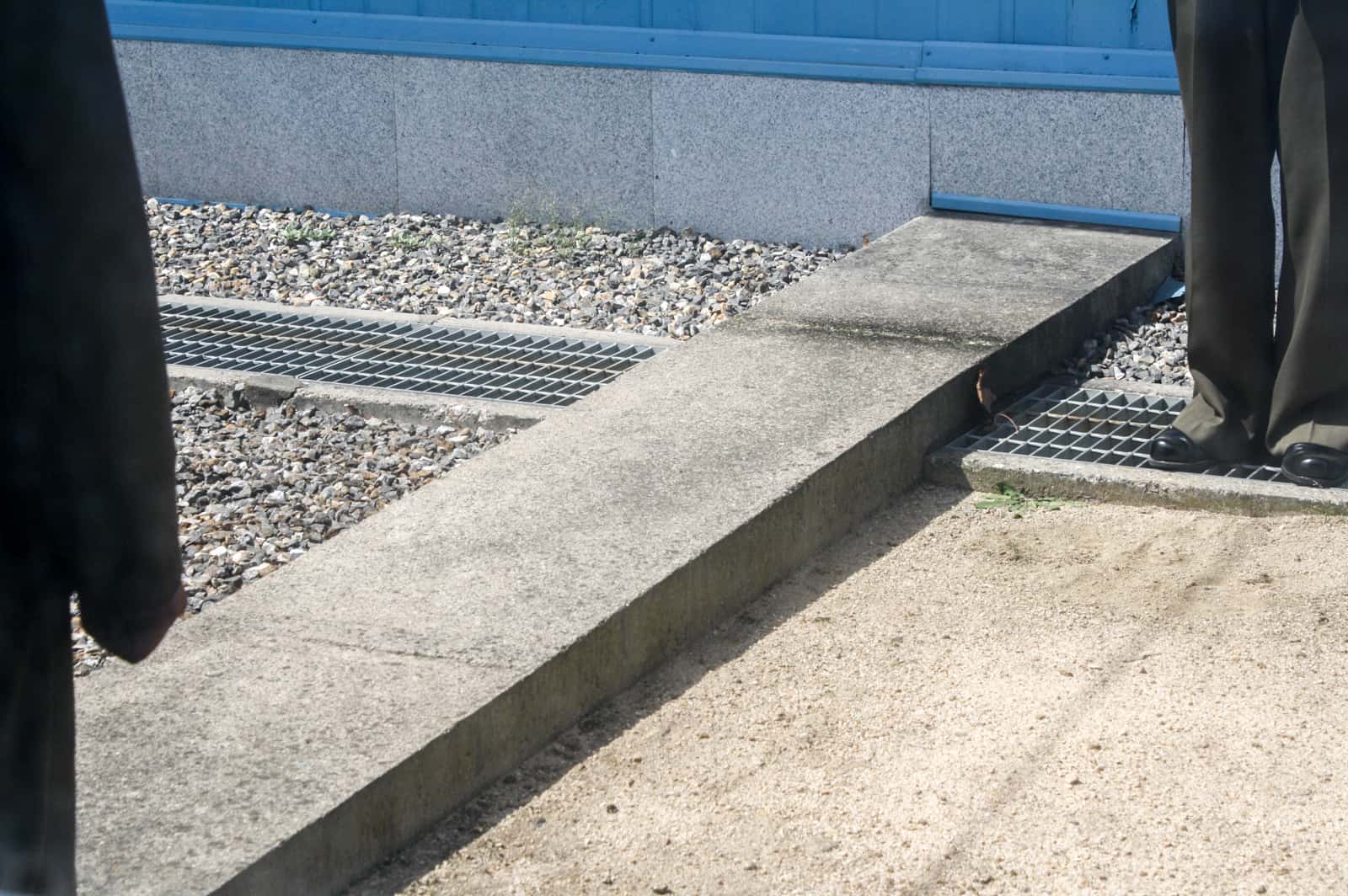
The DMZ Military Demarcation Line at Panmunjom, Korea.
What Part of the DMZ do I See as a Tourist?
When you travel to the Korean DMZ on a tour, you will visit the JSA. Here, you enter the Military Armistice Commission Conference Room – the only place where anyone can freely ‘cross’ the Demarcation Line.
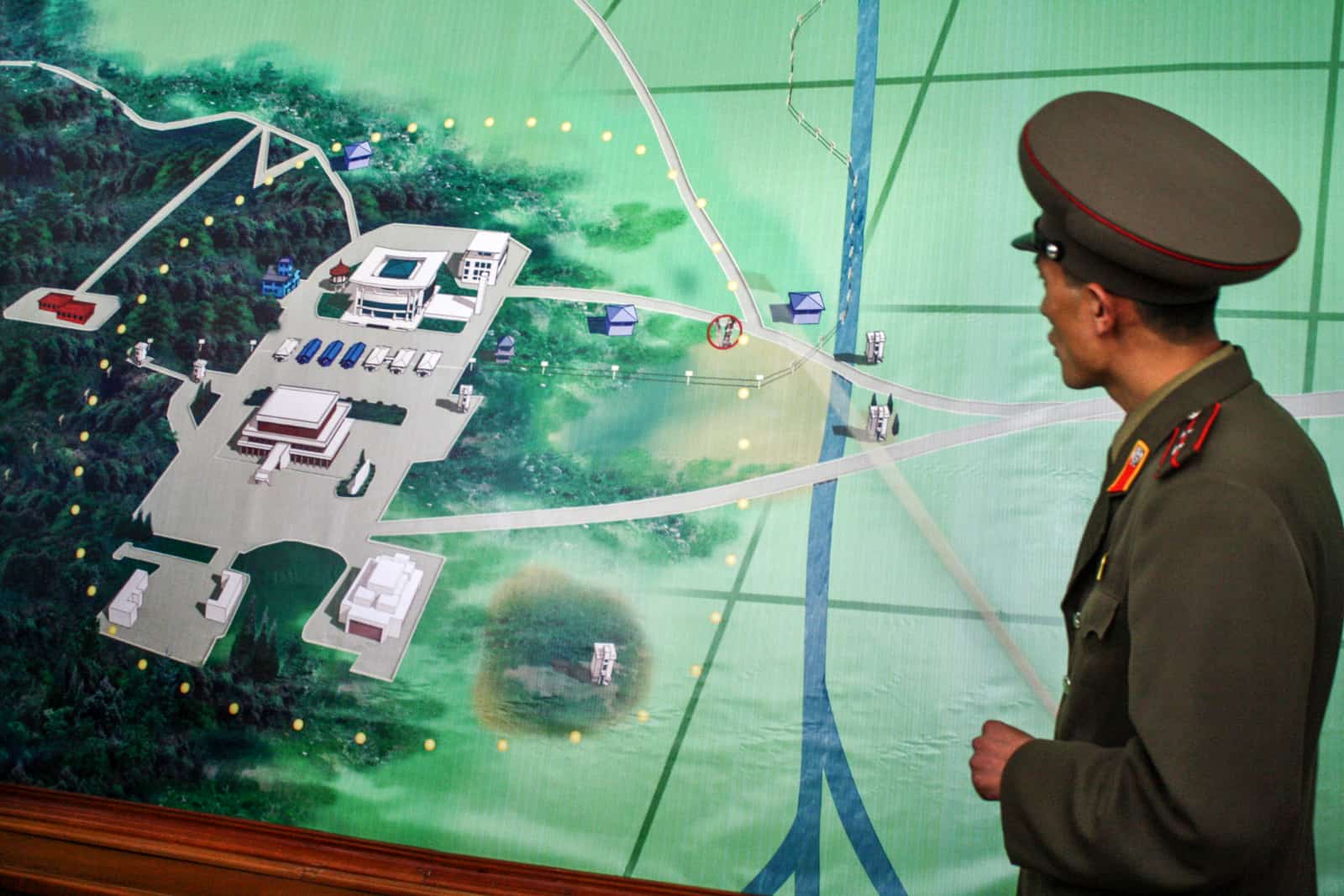
An explanation of the DMZ and JSA area by a North Korean guard.
How to Visit the DMZ in North Korea and South Korea
I have seen the DMZ from both sides of Korea.
For me, it’s how I wanted to see and understand it – from the TWO viewing points in Panmunjom. I stood on the North Korean side in November 2012, and in South Korea a year later.
However, despite the viewing lines being only meters away from each other and the room you enter being the same one, they were both very different experiences.
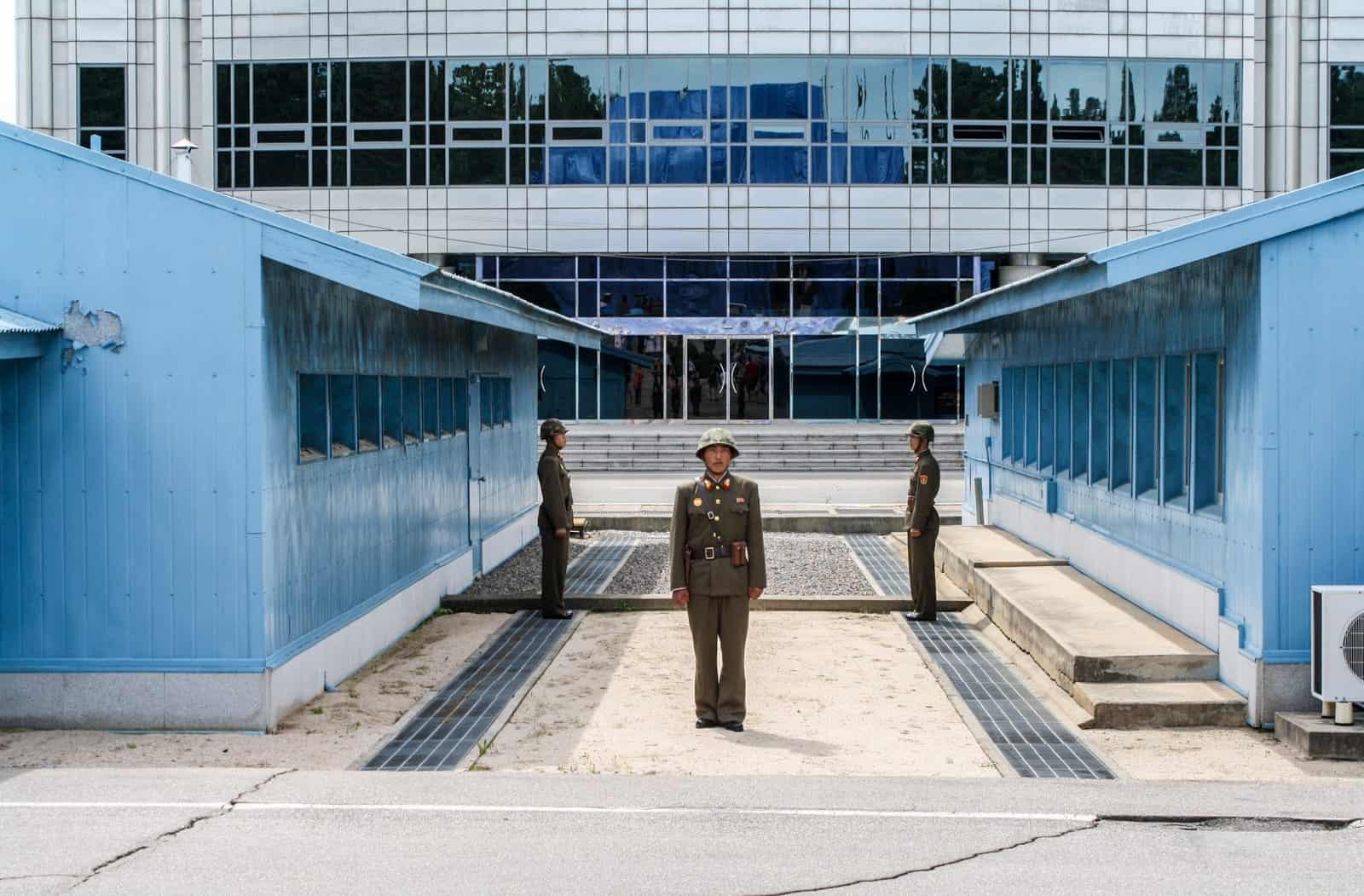
North Korean Guards at the DMZ DPRK Side
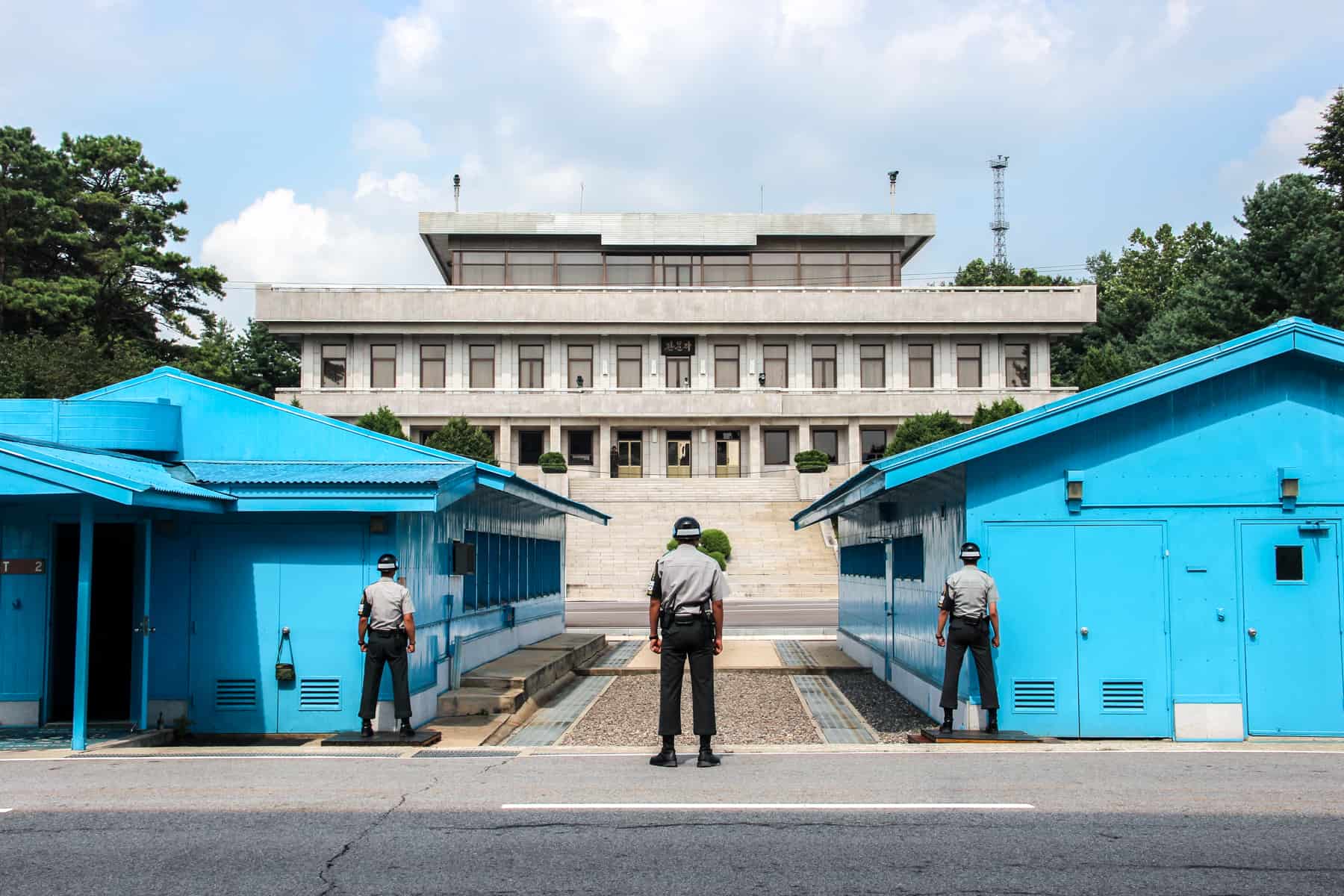
South Korean Guards at the DMZ facing the North Korean side
The DMZ in North Korea (DPRK)
Visiting the DMZ from North Korea was filled with adrenalin and a little fear. Not only were we in the world’s most closed country, but we were also on the world’s most dangerous border between two countries still technically at war.
To say we were on our guard here, despite being in the safety of a group, is an understatement. It took us around three hours to reach Panmunjom from the Capital of Pyongyang, where we all waited at a busy check-in area (complete with souvenir shops) as we watched our North Korean guides have their passports swiped firmly out of their hands.
It was time to get on the coach and drive the short way to the JSA, driving through a long road lined with large square boulders that would fall and block the road should any sign of attack be imminent (the same tactic exists on the South Korean side).
It felt tense, yet we were calmed upon arrival by the opportunity to look through historical artefacts, documents, and historical boards in a building designated as a North Korea museum – propaganda and all. It was, in fact, where the Korean Armistice Agreement was signed.
Our North Korean military guide was an approachable man, and not half as scary as I imagined him to be. He spoke the North Korean version of events, yet it wasn’t as propaganda heavy as other situations we had found ourselves in. It felt far more serious here, being so close to the ‘opposition’.
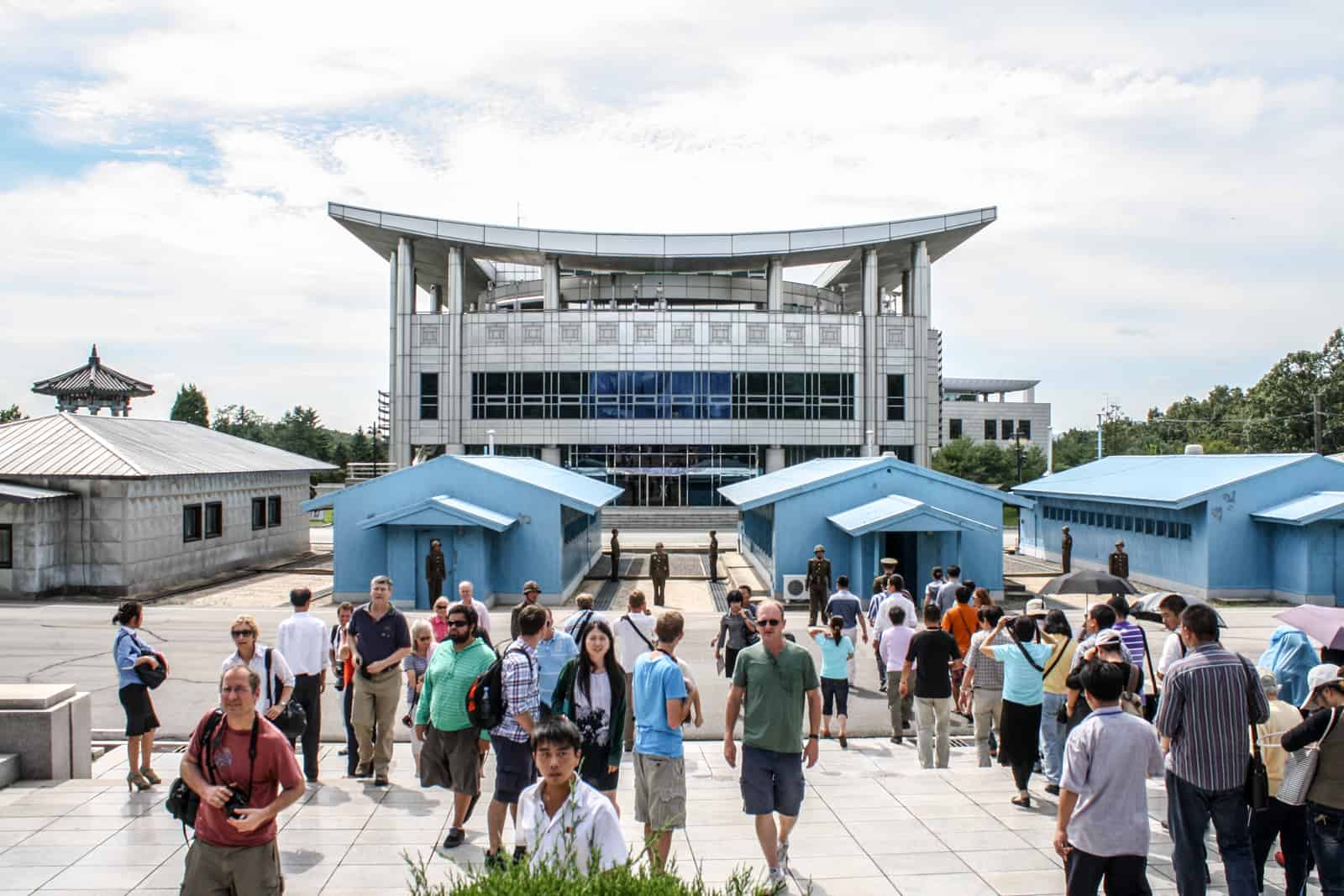
A DMZ JSA tour from North Korea.
Taking us through to the viewing platform, through an imposing, beige building, we all stood on the steps of the building looking out over to the building on the South Korean side. It was surprisingly calm, yet it felt incredibly eerie. No South Korean soldiers were present, just North Korean soldiers keeping guard.
There wasn’t the grand face-off we hear about in the media. I guess this is toned down during visits, with designated times given to both sides for tourist arrivals.
Only when we are gone, do they stand literally face-to-face with one another.
After 10 minutes or so, we were then taken into the blue hut – the Military Armistice Commission Conference Room that straddles the Demarcation Line. We were allowed to sit at the table (the ‘line’ cutting through the middle of the table) and, watched over by our guide, we all sat on either side of the table shaking hands across it, marking the peace we all wish for.
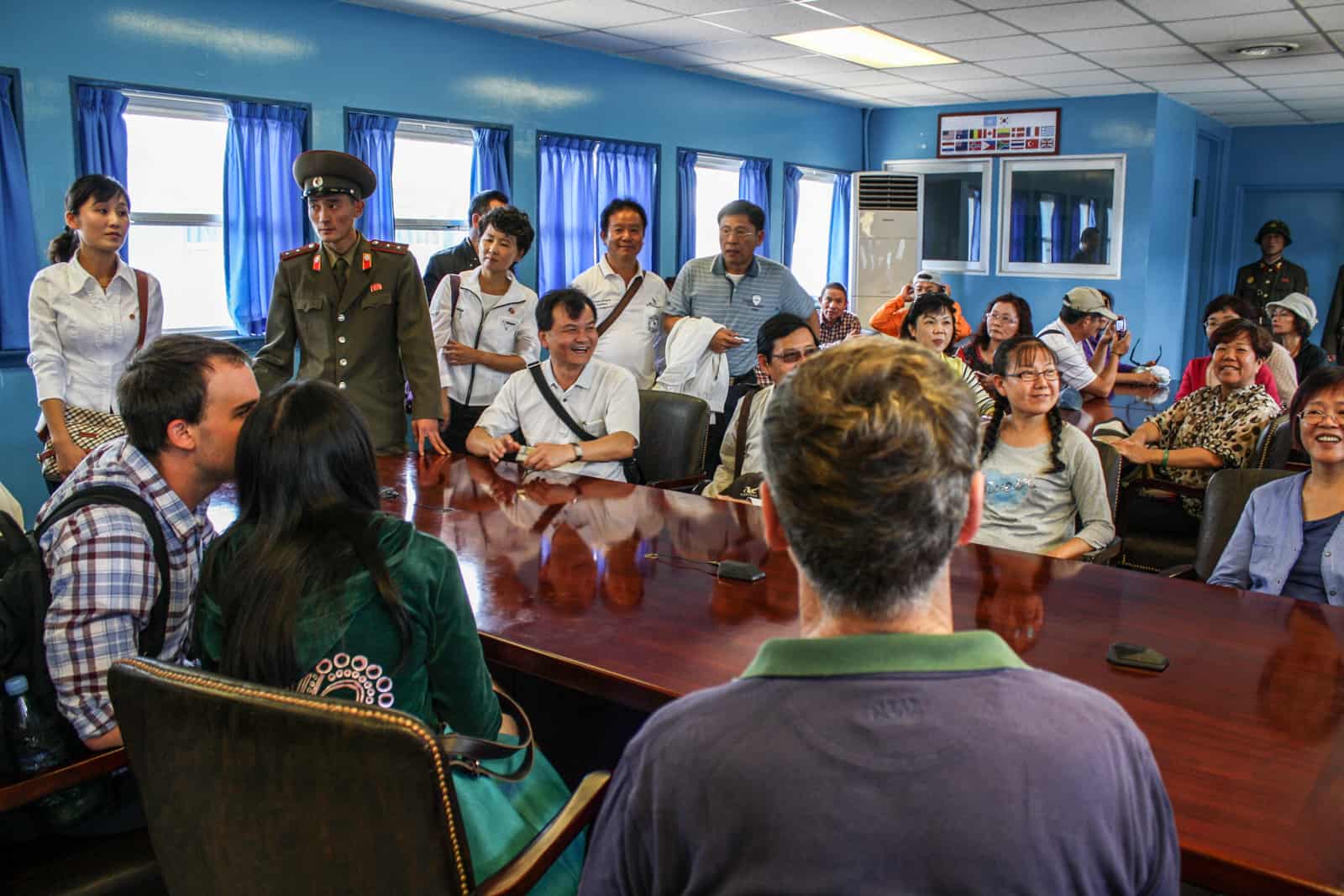
Visiting the DMZ Military Armistice Commission Conference Room
One North Korean guard stood staunchly guarding the door that leads to the South Korean side of the JSA, his fierce and set expression creating an atmosphere in the room that signalled this as very serious business. It was a day none of us could forget.
READ MORE: Travel to North Korea – Where Preconceptions and Reality Collide
The DMZ in South Korea (Republic)
In South Korea, DMZ tourism is a big business. Here, you can choose from a multitude of DMZ tours from Seoul, from full-day visits, JSA only tours to hikes and tours with North Korean defectors.
I decided on a full-day tour in order to see a series of historical sites and relics that can help formulate a better picture of the division between North and South Korea and setbacks to reunification.
The sites you see on this tour include:
The ‘Friendship Bridge’, a train station that links both countries via a single line, but whose full service is obviously not in use. However, some tours do allow you the opportunity to take a short journey on part of it, on the DMZ Peace Train from Imjingak to Dorosan Station, which you also visit.

View to the Friendship bridge from unused sections of the railway line intended to connect South and North Korea.

The Friendship Bridge – part of a railway intended to link both countries via a single line.
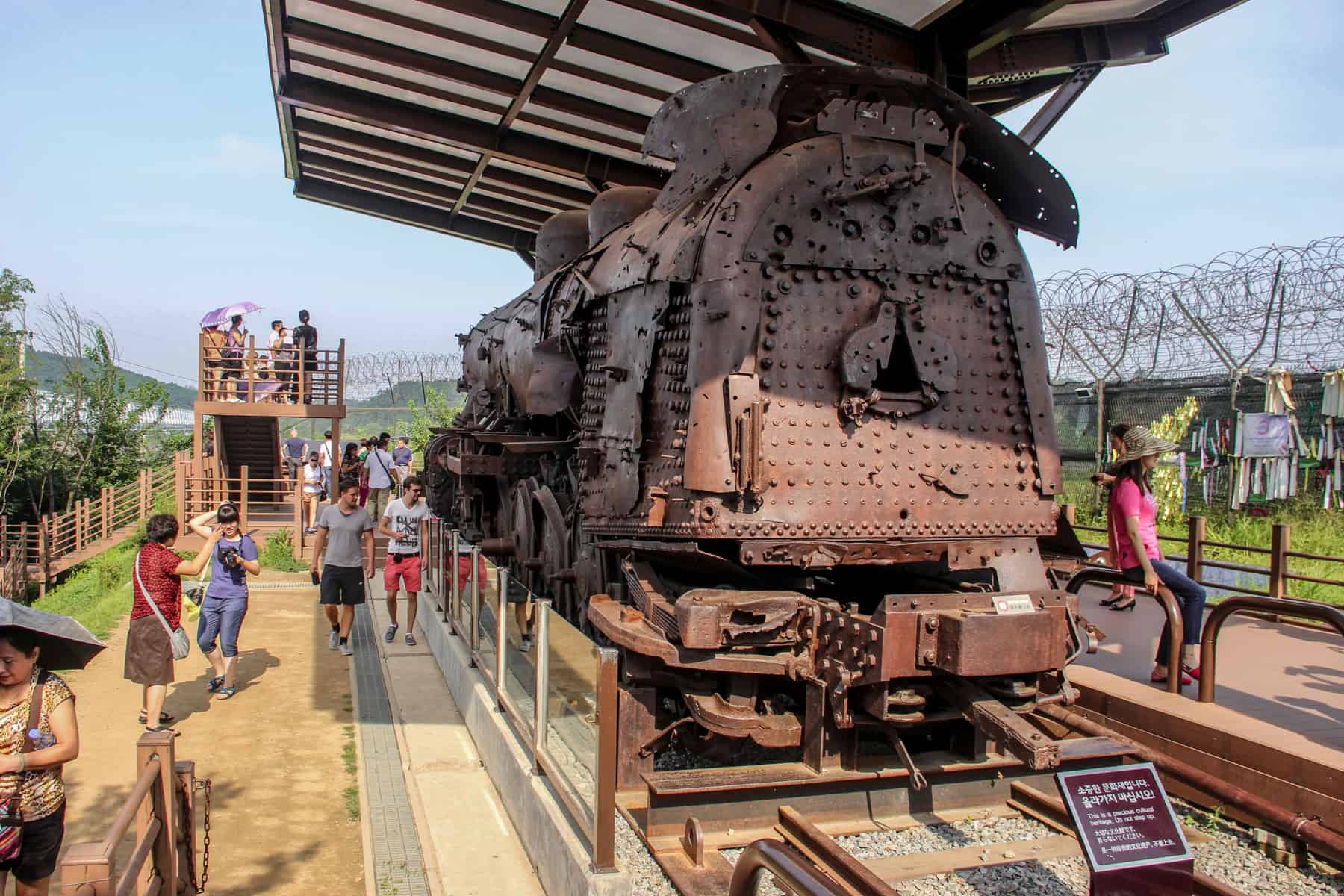
The metal relic of an old steam locomotive, derailed by bombs during the Korean War.

Inside Dorasan Train Station – part of the ‘Peace Train’ intended to connect to Pyeongyang, the capital of North Korea.
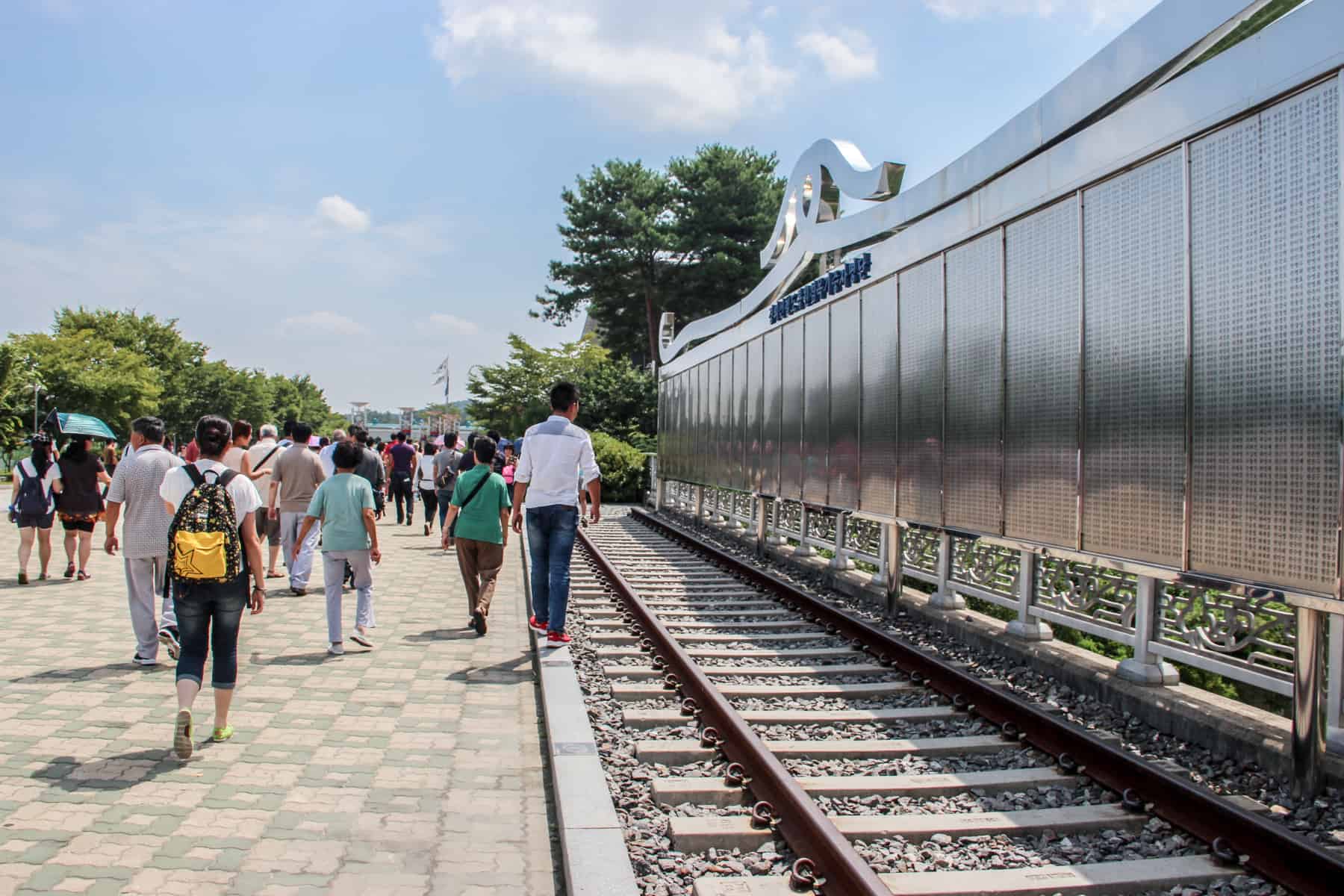
Dorasan Train Station Memorial.
The Dora Observatory where you can look out over North Korea. The most prominent lookout point is to the North Korean ‘Propaganda Village’.
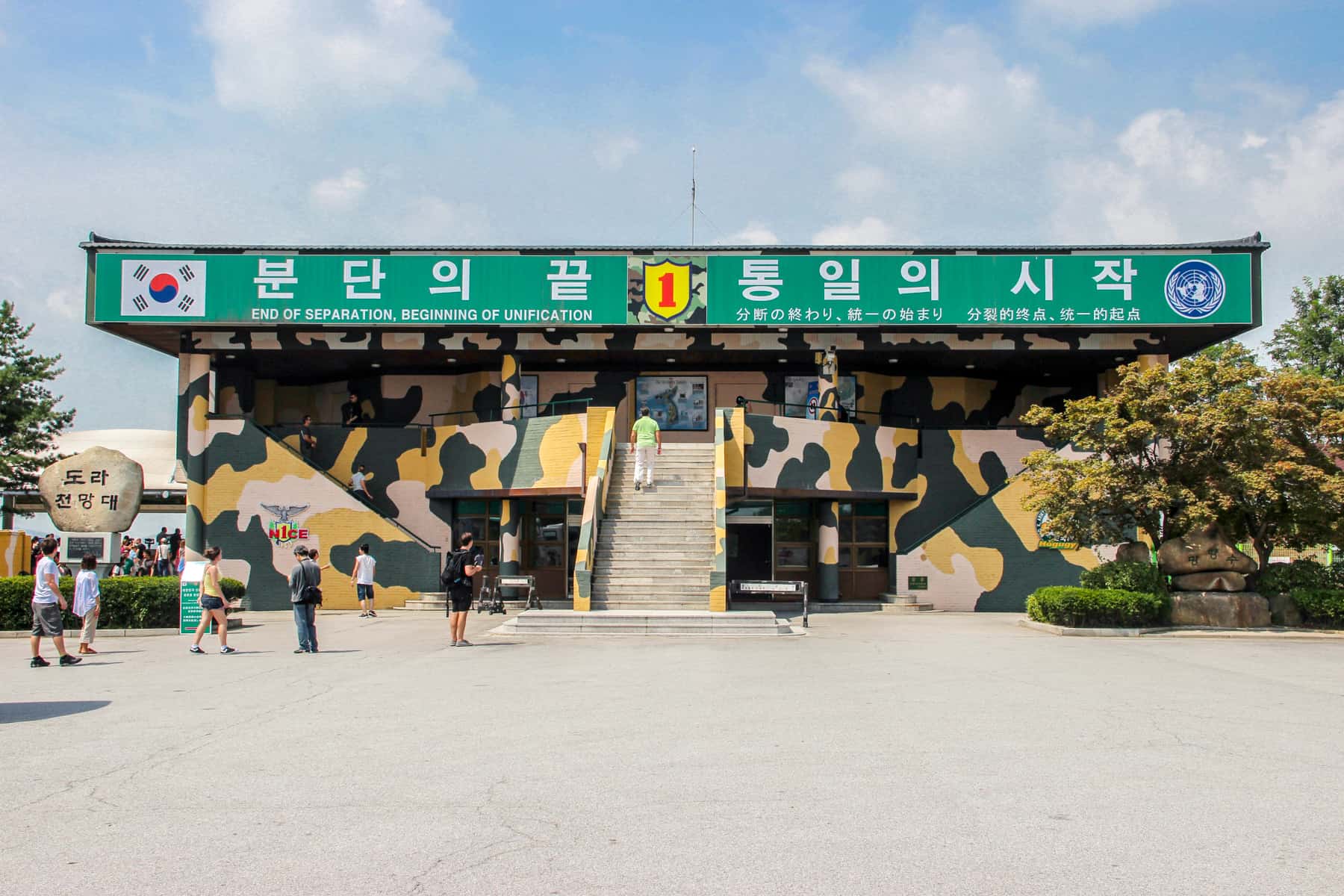
The Dora Observatory at the DMZ – the main lookout point facing North Korea.
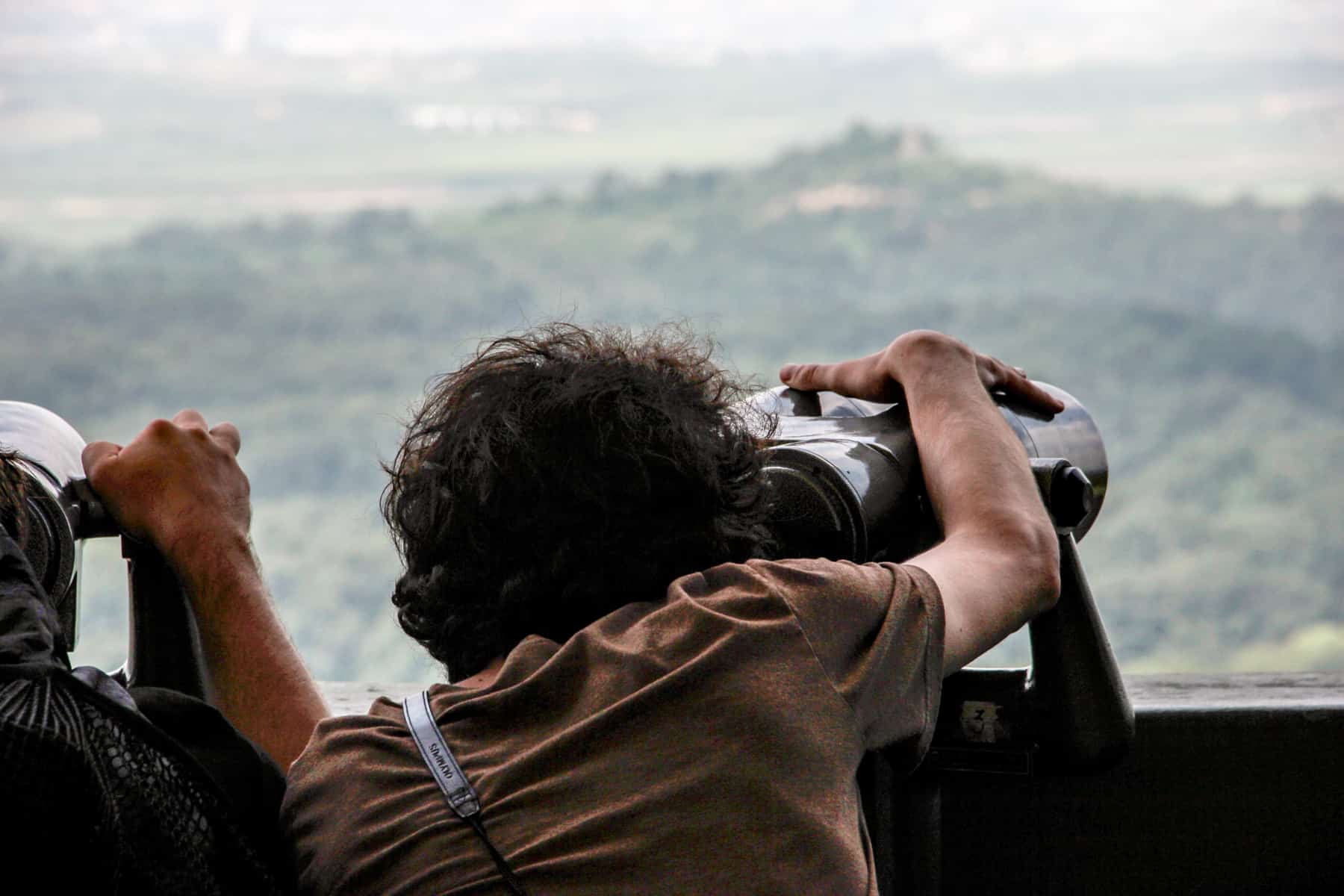
Binocular views to North Korea.
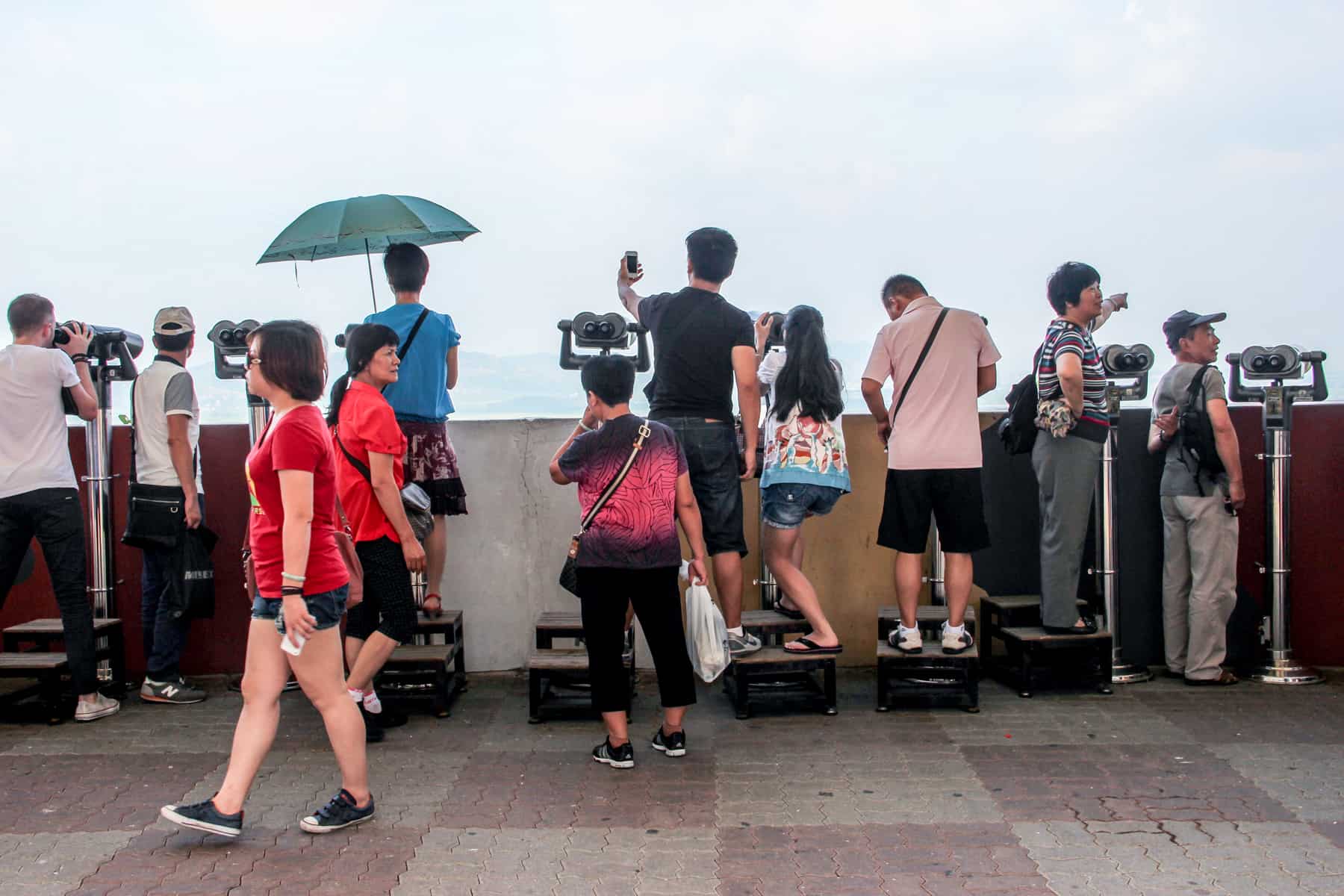
The Dora Observatory where visitors eagerly gaze into North Korea’s Propaganda Village.
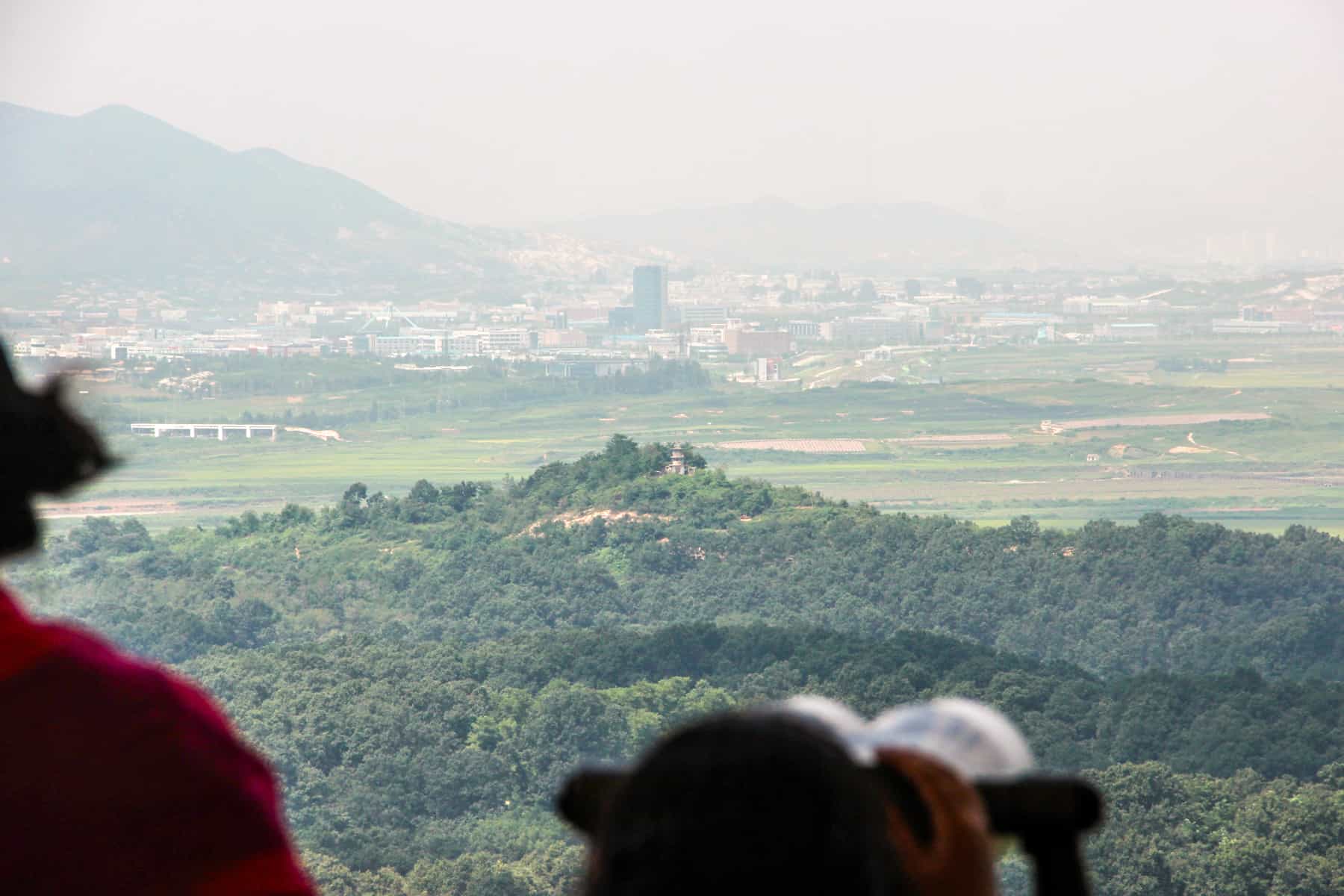
The North Korea Propaganda Village as seen on a DMZ tour.
The 3rd Tunnel (Third Infiltration Tunnel) – a 1,632m tunnel dug by the North Koreans, from which they could pass through into Seoul within an hour and invade, alongside tourism documentation and video centres.
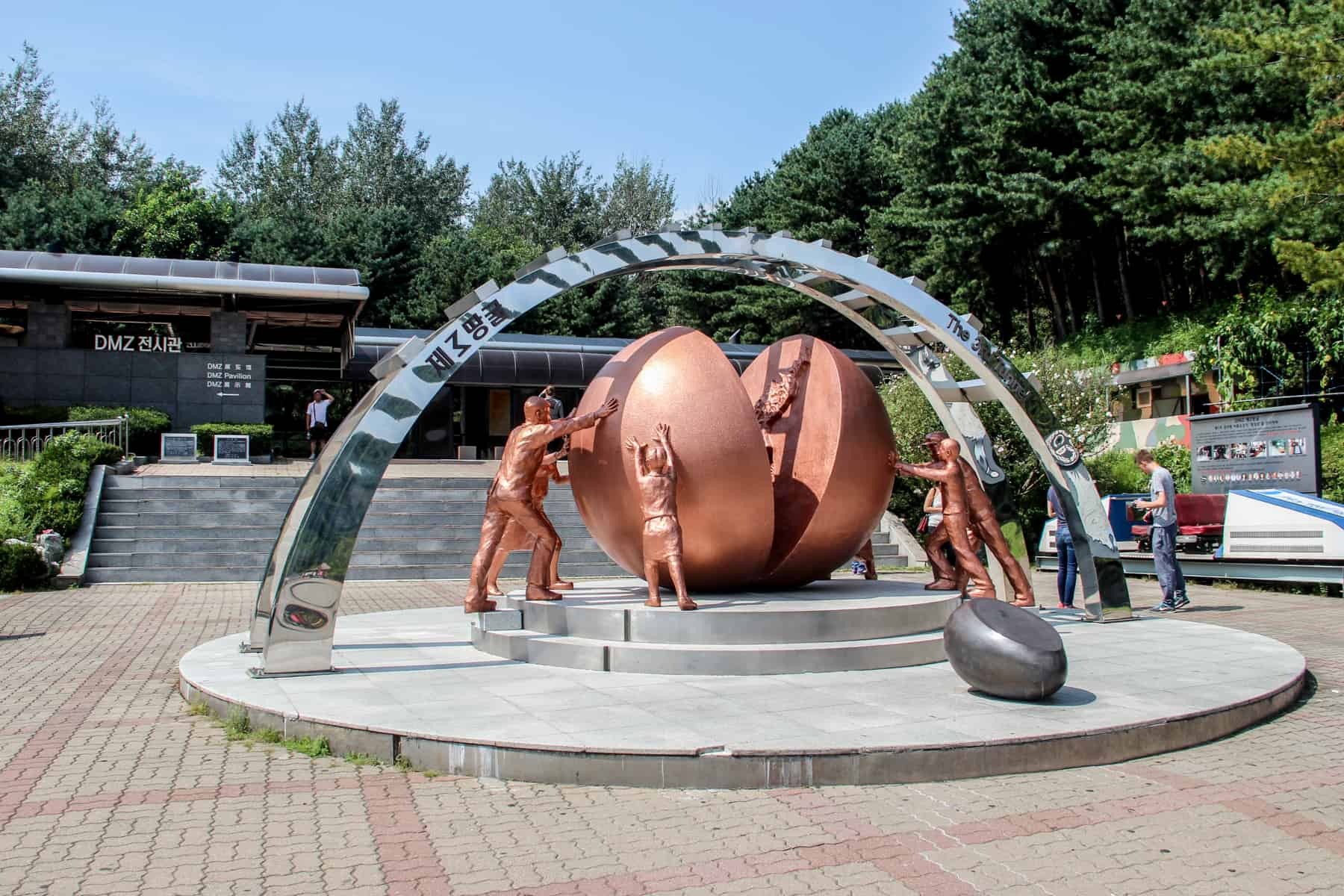
The artwork depicting reunification, marking the entrance site of the Third Infiltration Tunnel at the DMZ.
The last stop of the DMZ tour is the main site – the Joint Security Area (JSA) at Panmunjom. Here, you are shown a video and given a short introduction about South Korea’s version of events and how the US military operates here, before visiting the Military Armistice Commission Conference Room (one if the blue buildings). You are not allowed to sit down or touch anything in the Conference Room, contrary to the more relaxed visit when entering from the North Korean side.
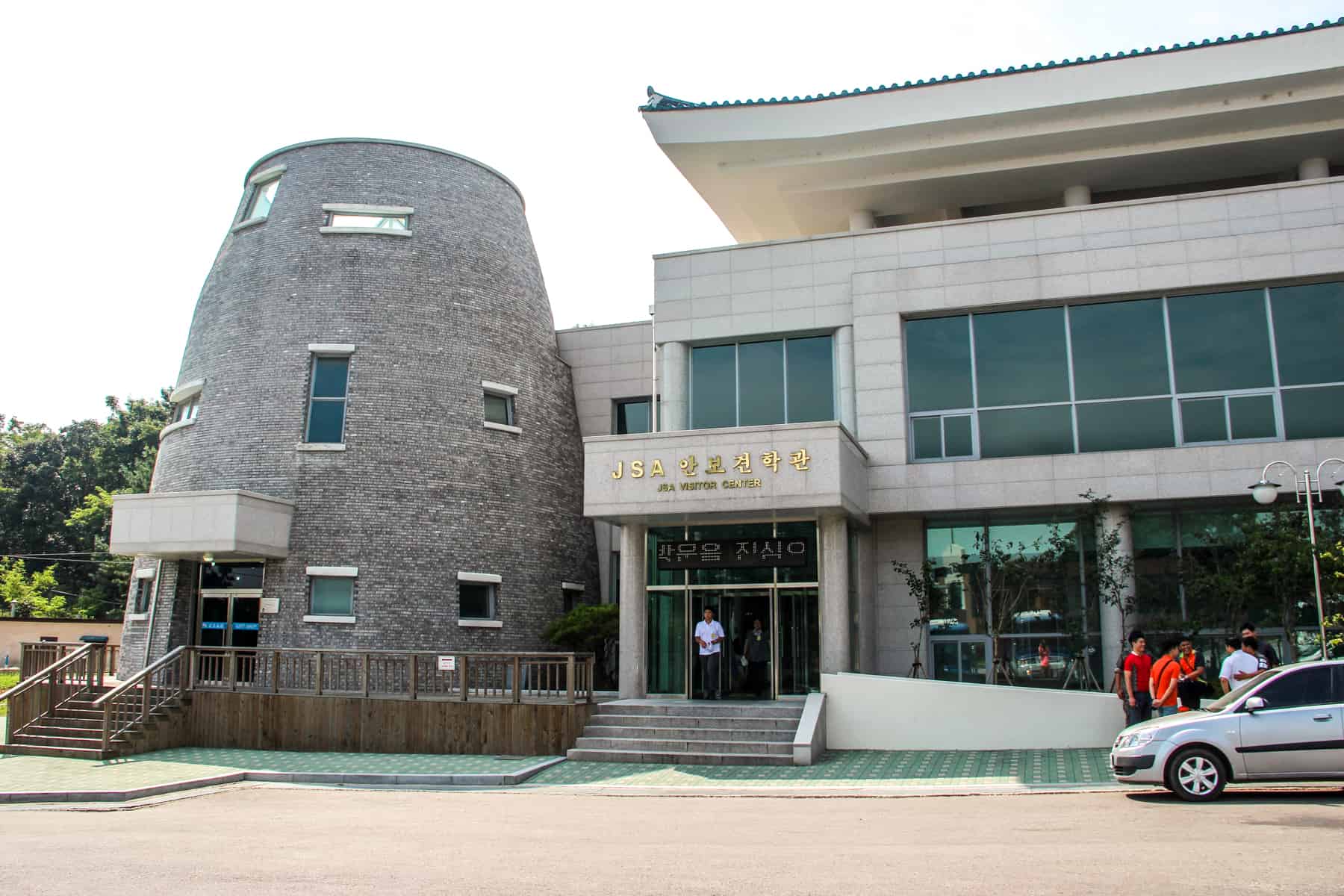
The most significant site when you tour the DMZ, is the Joint Security Area (JSA) Visitor Centre.
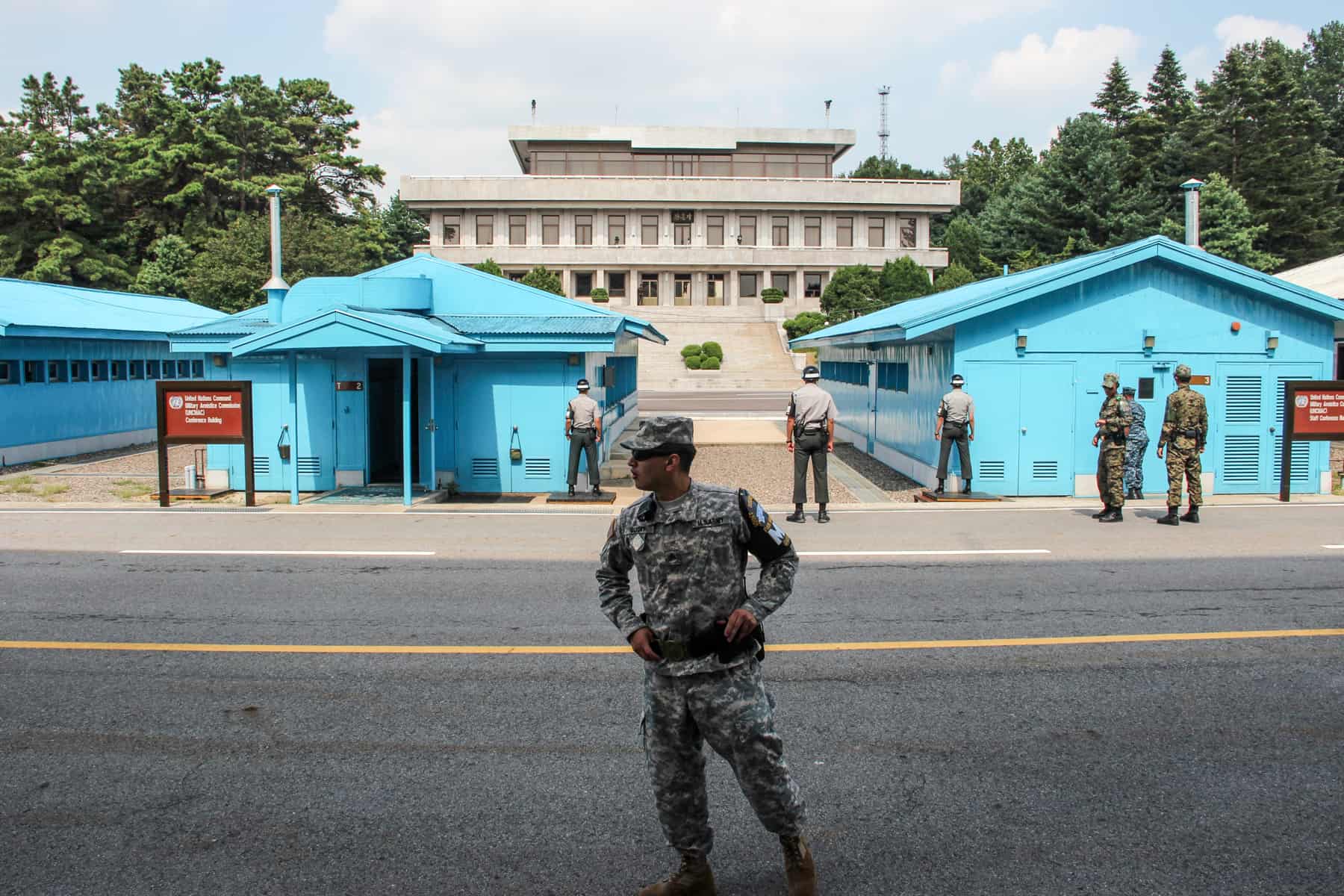
American military guides you throughout the JSA tour, seen here before entering the Conference Room.
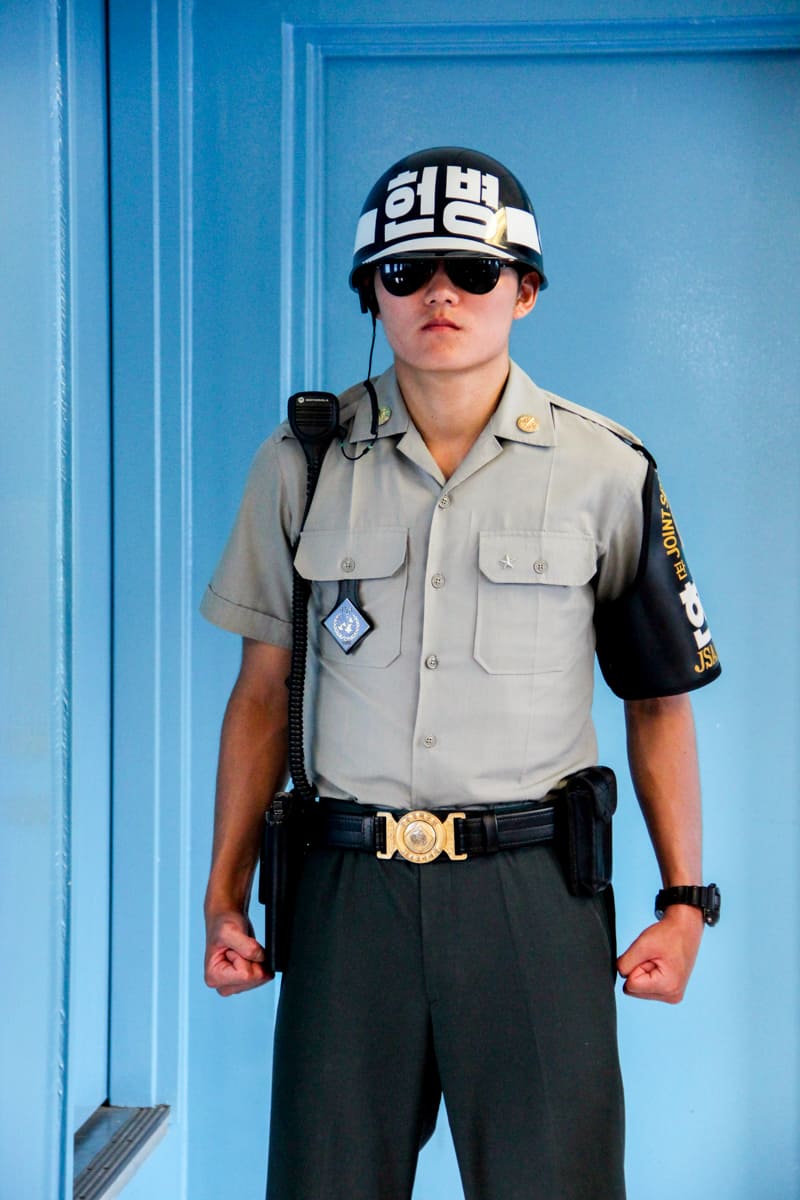
A South Korean guard in Taekwondo stance inside the Military Armistice Commission Conference Room.
The Reality When You Tour the DMZ
As a tourist site, there are a few aspects of the DMZ tours that conflict with the seriousness of the situation.
For many of the tourists at the DMZ, I don’t think they really understood exactly where they were. At times, it felt like a day trip to Disneyland. This is at no fault of the tour company, which facilitates your transport between each of the sites and provides knowledgeable background and historical insights on the coach along the way, but the fault of who is behind the tourism surrounding this particular area. It could be the government, or whoever thought it was acceptable to build a fairground next to the area where the bridge is. Or those who thought it was acceptable to allow the Observation Deck to turn into a zoo-like atmosphere, surrounded by the screams of people looking through telescopes exclaiming, “Oh.My.God. I just saw an actual North Korean.” Yes, this really happened.
Never once did I feel the DMZ visit in South Korea was a serious issue or treated as a serious place. The US soldier, our guide, was young, knowledgeable and delivered a fantastic presentation that was factual and historically sound. Yet, for the most part, it’s treated as a bit of fun peering into the hermit kingdom. While people on the ground cannot change the ignorance and stupidity of some of the tourists who visit, there could be more educational markers put in place and the enforcement of more rules to encourage a little respect.
I felt that ‘reunification’ was nothing more than a throwaway term, later confounded by many South Koreans I met who said: “Many of us are not bothered by it”.
North Korean guards were present; they lurked in the shadows and behind the pillars of the beige building I had once stood at months before. We were informed of some rules to follow – we were not to take pictures of any North Korean guards that may appear in the building in the background, and not to make any faces or hand gestures that they can film and use as propaganda, or as a means of retaliation. Whilst I felt safe, the viewing point time felt unnerving, especially being around US soldiers who had a frivolous, laddish, macho attitude, and were themselves making gestures.
Time in the JSA conference room is more strict. Back in the blue building (the Military Armistice Commission Conference Room), we were once again told about the DMZ and the guard line, except we were not allowed to sit at the table, only stand around it. South Korean guards stood in their fierce Taekwondo stance – something of which they are famous for – yet tourists giggled and replicated the pose for photos.
That was something we would never have dreamt of doing on the North Korean side.
READ MORE: Travelling in South Korea – A Guide (But Glad I Gave it a Chance)
Should a Visiting the DMZ be on Your Korea Itinerary?
A visit to the DMZ is without a doubt an eye-opener and a must-see for those interested in history and current affairs. While a visit to North Korea is undoubtedly going to be fuelled by a more serious attitude, where you have to be guarded and ‘on your best behaviour’ at all times, I sadly think people miss the point when visiting on the South Korean side. A few people around me expressed disappointment with the way things were handled.
It’s a given that the majority of visitors will visit from South Korea, and so I would personally cut out the full-day tour and just stick with the specific JSA tour, yet be prepared for mixed signals regarding the seriousness of the current situation. However, for those with a deep interest in what is going on here, you will certainly take a lot more from the full-day visit of multiple sites.
As one South Korean woman said to me: “People have lost the meaning of what the DMZ is and what it’s there for. Like it’s a fun thing to do.” So when you visit the DMZ be sure to remember exactly what it stands for, why it exists and the people who have died protecting the border or trying to escape from it.
Book a DMZ Tour
DMZ Tour North Korea
I visited the DMZ on the North Korean side during my trip to the country with Koryo Tours. The JSA tour formed one afternoon as part of a seven-day trip to the country.
DMZ Tour South Korea
In South Korea, my visit to the DMZ was a day tour with VIP Travel, considered to be the best DMZ/JSR tour agency in Seoul.
The full-day ‘DMZ and Panmunjeom Tour’ (from 8 am until 5 pm) runs every day (except on Sundays, Mondays, National Holidays, and Military Training Days) and costs 135,000 Korean Won / around $120 US per person. You can read a full overview of the trip here.
The sites you see on this tour are: Imjingak Park → The Bridge of Freedom → The 3rd Infiltration Tunnel → DMZ Theater & Exhibition Hall → Dora Observatory → Dorasan Station → Pass by Unification Village → ID Check Point → Camp Bonifas → JSA (Freedom House, Conference Room)
Bookings need to be made at least 48 hours before the chosen day of the tour.
Planning to Visit the DMZ in Korea? Save for Later.

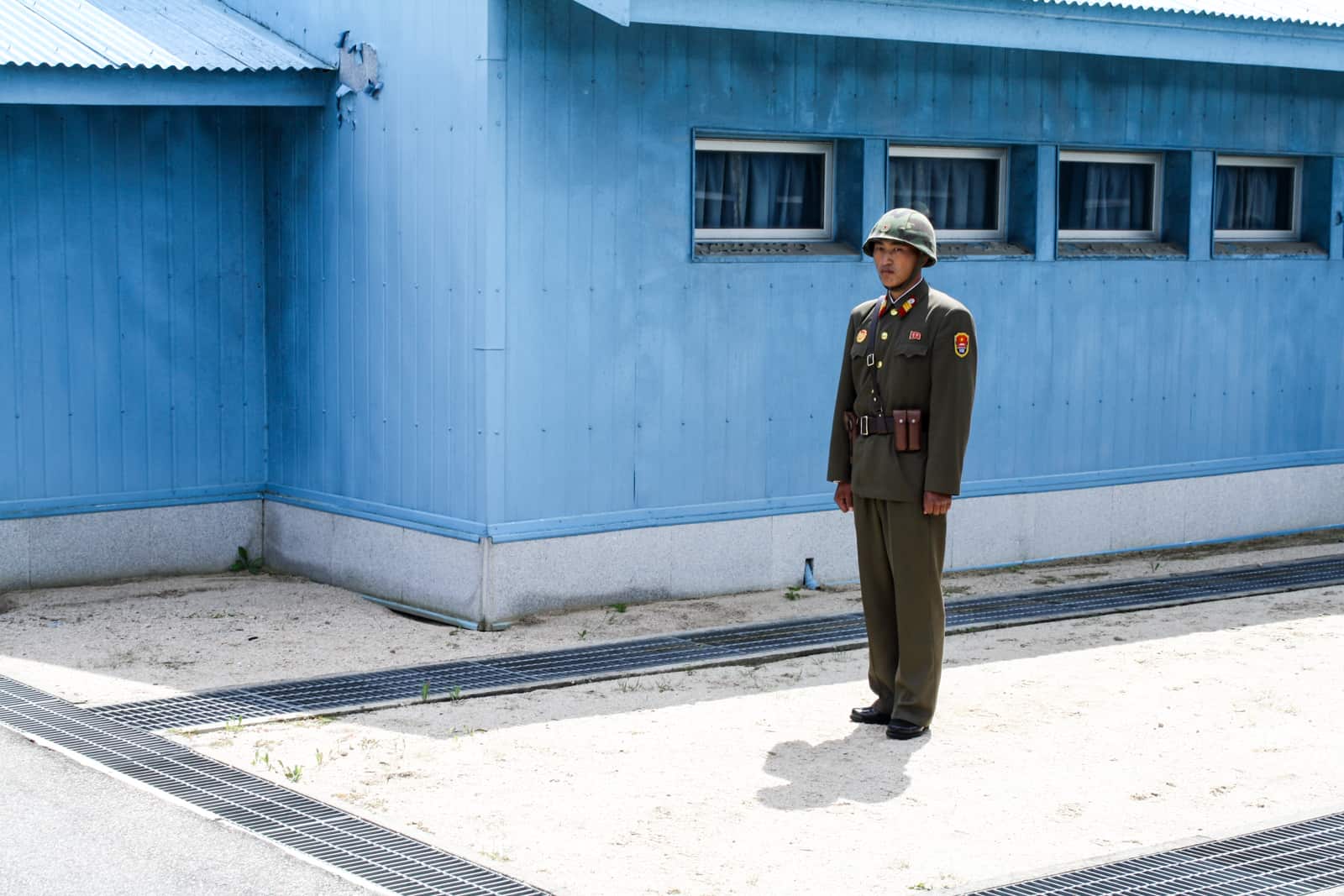
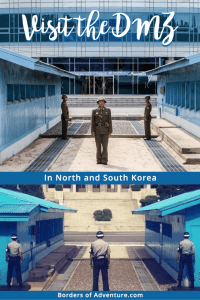

Arthur Hernandez says
December 1967 thru January 1968.
I was assigned as an Army medic to an infantry company with the 2nd Infantry Division that made patrols along the DMZ. We lived in tents in the JSA area. I remember that there
was a chopper pad, a small hut that served as a PX where we bought Playboy, candy, writing stationery, tooth paste and other small items that were part of our infantry
lives.
Along the DMZ on our patrols there was not much of a fence and sometimes you would
see holes that had been cut so that a person(s) could make their way through. We found a tunnel and the Captain lined up five infantry guys shoulder to shoulder with full packs to get an idea of how many troops could pass through. I remember Freedom Village, Freedom Bridge and the Imjin River. Most of all, I remember the grunts, the Infantry guys. I do not remember so much their names but their faces when it was bitter cold and it snowed or it rained sheets of rain and they did guard duty in foxholes manning the 50 caliber machine gun. During this time period, the Pueblo ship was seized and North Korean infiltrators came across to kill the South Korean President. On one of our patrols, we captured two of them and killed one of them who was about to throw a grenade. Second Infantry Division-Second to None! I salute the grunts who called me Doc and took care of me. I still remember.
Matt says
I would love to visit the DPRK side of the DMZ. I feel as though it would be an intersting outlook on the conflict and history. From videos I’ve seen of tours into the DPRK side the DPRK troops and guides seem rather approachable compared to what I would have thought initially. I feel like getting a tour from the South side with US troops would annoy me alittle as most videos I’ve seen of those tours show soldiers going out of their way to insult the north every minute or so. Some of the insults are, frankly, pathetic from the point of view of someone who knows about the Korean War and the two Koreas respectively. I am currently planning out a world trip and would like to visit the DMZ but am unsure of where I would sign up for that. Regardless, thank you for the information and a good read.
lewskannen says
Interesting article Becki.
I want to mention something that people seem to have not picked up on.
I went on the tour from the south in 1996 and again in 2008. There was a marked difference and the second one was a lot more relaxed with more people, more time, more freedom to move around a bit and less control. It was still rather tightly controlled however.
In 1997 I toured from the north and I was also surprised at how much more relaxed and almost informal it was compared with the tour from the south six months previously.
The reason is pretty clear however. The north knows that the ROK and US troops are not going to do anything unpredictable, they are just going to stand an watch.
When the guards in the south are in charge of several dozen tourists (like herding cats) they have to keep them under tight control firstly because they do not know what the north korean guards might do next without warning and secondly they don’t know what some dumb tourist might do which could cause an incident with the always-ready-to-take-offense North Koreans.
A fool like Stan Squires might get some kick out of disrespecting ROK and US guards because he knows he is safe. I have noticed however that even fools know when to pull their heads in and they are always on best behaviour when they need to be. ie if they happen to be in DPRK.
Sela Jane Aholelei says
Heya 🙂 was looking up information on DMZ as I am now living in South Korea and its on my to-do list of places to visit while here. Just wanted to say that your experience at the DMZ has been beyond informative in how I want to approach my visit! Thanks for an interesting read. Glad I came across this!
Darrell Pickett says
Patrolled the DMZ (inside the fence) in 1968 and 1969 and also conducted night ambushes. Toured Panmanjom within days of NK ambush which brutally killed American soldiers. Toured also shortly after person was attacked and injured within the JSA by NK soldiers. Don’t let “now” fool you as to what it used to be.
Lina says
Hey there! Great article, my husband and I just visited the DMZ and JSA from the South Korean side a couple months ago. I agree with you 100% that the DMZ tours are a circus. I had a hard time with it because people were so disrespectful and our guide wasn’t that great either, she rushed through everything. Our trip to the JSA though, was the complete opposite. We had an older women as a guide and she was very strict and serious. We were given strict orders, nobody screwed around and we all followed the rules in a respective manner. It was one of the most unique experiences we have had on our travels to date. We too want to visit North Korea.. will be checking out your other articles on the subject. Cheers!
julien says
I think it’s sad another example of the lunacy of man , will we ever see a united korea ? with the wide gaps in income it would make the reunification of east Germany and West look like as easy as organising a chook raffle at a beer garden.
Ross says
Great story and cool that you got to both sides to see how they both approach it. It does sound very scary though especially on the NKorean side.
Becki says
It’s more tense on the North Korea side, rather than scary. But the approach from both is completely different for sure.
Ashly says
Loved it …the extra mile that you took to understand the two perspectives ! The way you take up your trips and cherish the experience – that gives me lots of inspirations to me. Thanks a ton for the posts !
Caitlyn says
Really interesting to read. I went on a tour from Seoul with the US Army, basically I was the only person on the tour who wasn’t a US veteran so it offered a unique experience. I found the propaganda to be quite full-on, there was no mention of the fact that the south wasn’t even really a democracy until the late 1980s. It was very much good guys versus bad guys. Don’t know if I’ll ever get a chance to see it from the North, so I’ll stick to your observations for now 🙂
Becki says
What an interesting perspective to have been given – would love to know more about your trip there. I agree on the good guys vs the bad guys thing – they both say things about the ‘other side’, which is why I am shocked when many people do not realise that the south pushes out it’s own propaganda too. I actually met some British army guys who had gone on a special tour. It was probably the same one that you went on.
Michael Windham says
Hi Miss Becki….bravo to you for taking on one of the most threatening experiences available to any traveler in the world today. You have the guts to be a US Marine. If you’d have been one when I was in Vietnam I would have been proud to have had you by my side!
This explanation is the only way I have to say how proud I am of your courage to go where most people don’t dare go!
You’re gorgeous to!!! Lol.
Seriously … This article was an incredible read. I could feel the tension on the north side and on the south side you weren’t anywhere near as interested which left me thinking of it just the way it actually is.
I wish you could have been in Soul in 1970 the 3 days I was there. I went from Vietnam there with a Korean Rock Marine who was assigned 4 hours a day to teach a group of US Marines teakwondo. He was a 7th dan black belt. You have to be invited to come to this advancement event of upper level belts given only once a year by the masters. He was to get his 8th… He took two students…. I was one if them. They allowed my attempt at my 2nd dan… I passed. He passed on his 8th and broke a hand!! These feats were nothing compared to the masters demonstrations. Things like an 80 year old man throwing 10 killing blows in less than one second. Only way of belief is to have been there. You would never believe the rest. You’re the type person who would be able to relate this type event to the normal reader. I can’t.
I love reading about your travel. It’s hard for me to sit down and read anymore. I don’t have that problem reading what you write. You’re frigin good! Lol.
Congrats on your award Becki, you deserve it!